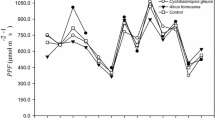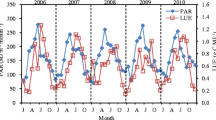Abstract
Net photosynthetic rate (Pn) increased in bamboo (Phyllostachy pubescens) with increased atmospheric CO2 concentrations. Average maximum Pn was 17.76, 16.66, and 16.77 (μmol/m2/s) in lower, middle and upper layers canopy respectively at CO2 saturation point. Light use efficiency of leaves ranged from 0.15% to 2.25% on different days and at different times of year measured by LP-6400 at 900 m altitude in the Tianmu Mountain Natural Reserve (TMNR) in Northwest Zhejiang Province, China. At two distant locations (TMNR and Lingfeng Bamboo Farm, Anji County) annual radiation conversion efficiency was 1.43% and 1.62% into total biomass (ET), and 0–1% into harvestable biomass (Eh). Carbon sequestration rates were 14.8, and 16.7 t/ha/annum at the two locations. We argue that expansion of bamboo forests into marginal lands of China, with improved management, offers real potential and options to counter climate change.

Similar content being viewed by others
References
Administration Authority for Tianmu Mountain Nature Reserve. 1992 Comprehensive Investigation Report on Natural Resource of Tianmu Mountain Reserve. Zhejiang Science and Technology Press, Hangzhou China Pages: 12–18, 39–53 (in Chinese)
China Energy Net. 2009 Bioethanoal Development and Potential in China, Feb., 16, 2009, (www.china5e.com)
DOE. 2008 International Energy Outlook (2008) US .Department of Energy, Washington DC (www.eia.doc.gov./oiaf/aeo/)
FAO media centre. 2010 World deforestation decrease, but remains alarming in many countries, March 25, 2010 (http://www.fao.org/news/story/pt/item/40893/icode/en)
Guo, Q. R., G. Y. Yng, T. Z. Du & J. M. Shi. 2005. Review on the Carbon Character of Chinese Bamboo Forests. Communication on World Bamboo and Rattan 3(3): 35–38 (in Chinese).
Heaton, E. A., J. Clifton-Brown, T. B. Voigt, M. B. Jones & S. P. Long. 2004. Miscanthus for renewable generation: European Union experience and projections for Illinois Mitigation and Adaptation. Strategies for Global Change 9: 433–451.
———, F. G. Dohleman & S. P. Long. 2008. Meeting US biofuel goals with less land: the potential of Miscanthus. Global Change Biology 14: 1–15.
Lin QY. 2007 Study the characteristics of carbon assimilation by Bamboo (phyllostachy Pubescens) plant in Tianmu Mountain. Master Degree Thesis, Graduate school of Zhejiang Agriculture and Forest University.
Gratani, L., M. F. Crescente, L. Varone, et al. 2008. Growth pattern and photosynthetic activity of different bamboo species growing in the Botanical Garden of Rome. Distribution Functional Ecology of Plant 203(1): 77–84.
Milliken, J., F. Joseck, M. Wang & E. Yuzugullu. 2007. The advanced energy Initiative. Journal of Power Sources 172: 121–131.
Parr J., L. Sullivan, BH. Chen, GF. Ye 2010 Carbon bio-sequestrated within the phytoliths of economic bamboo species Global Change Biology, doi:10.1111/j.1365-24862009.02118.x
Shi YC., 2008 Food! Petroleum! Biofue! Forum of Environment and Ecology for China June 08, 2008 (http://forum.eedu.org.cn) (in Chinese)
Shi, J. M., Q. R. Guo & G. Y. Yang. 2005. Dynamic Photosynthesis of Bamboo Forests. Forestry Science Research 18(5): 551–555 (in Chinese).
Zhou CF., 1998 Bamboo Silvia Culture. Chinese Forest Publishing House, Beijing China Pages: 17–19, 27, 103, 130, 179, 186, 199–200, 318, 387–391 (in Chinese)
Zhou, G. M. & P. K. Jiang. 2004. Density, storage, and spatial distribution of carbon in phyllostachy pubescences forest. Scientia Silvae Sinicae 40(6): 11–15 (in Chinese).
———, J. S. Wu & P. K. Jiang. 2006. Effect of different management models on carbon storage in phyllostachy Pubescens. Journal of Beijing Forestry University 28(6): 51–55 (in Chinese).
Acknowledgement
We would like to acknowledge the financial support from Zhejiang A & F University, China, and also express our appreciation to Miss Q.Y. Lin, Mr. J.S. Wu and Mr. X.B. Qian for their assistance in field measurements and laboratory analysis. We would also like to express our sincerely thanks to two reviewers and Dr. Anna O.W. Leung for their valuable comments in improving the quality of this paper in scientific point of view and for English editing.
Author information
Authors and Affiliations
Corresponding author
Rights and permissions
About this article
Cite this article
Cao, Z., Zhou, G., Wen, G. et al. Bamboo in Subtropical China: Efficiency of Solar Conversion into Biomass and CO2 Sequestration. Bot. Rev. 77, 190–196 (2011). https://doi.org/10.1007/s12229-011-9075-y
Published:
Issue Date:
DOI: https://doi.org/10.1007/s12229-011-9075-y




